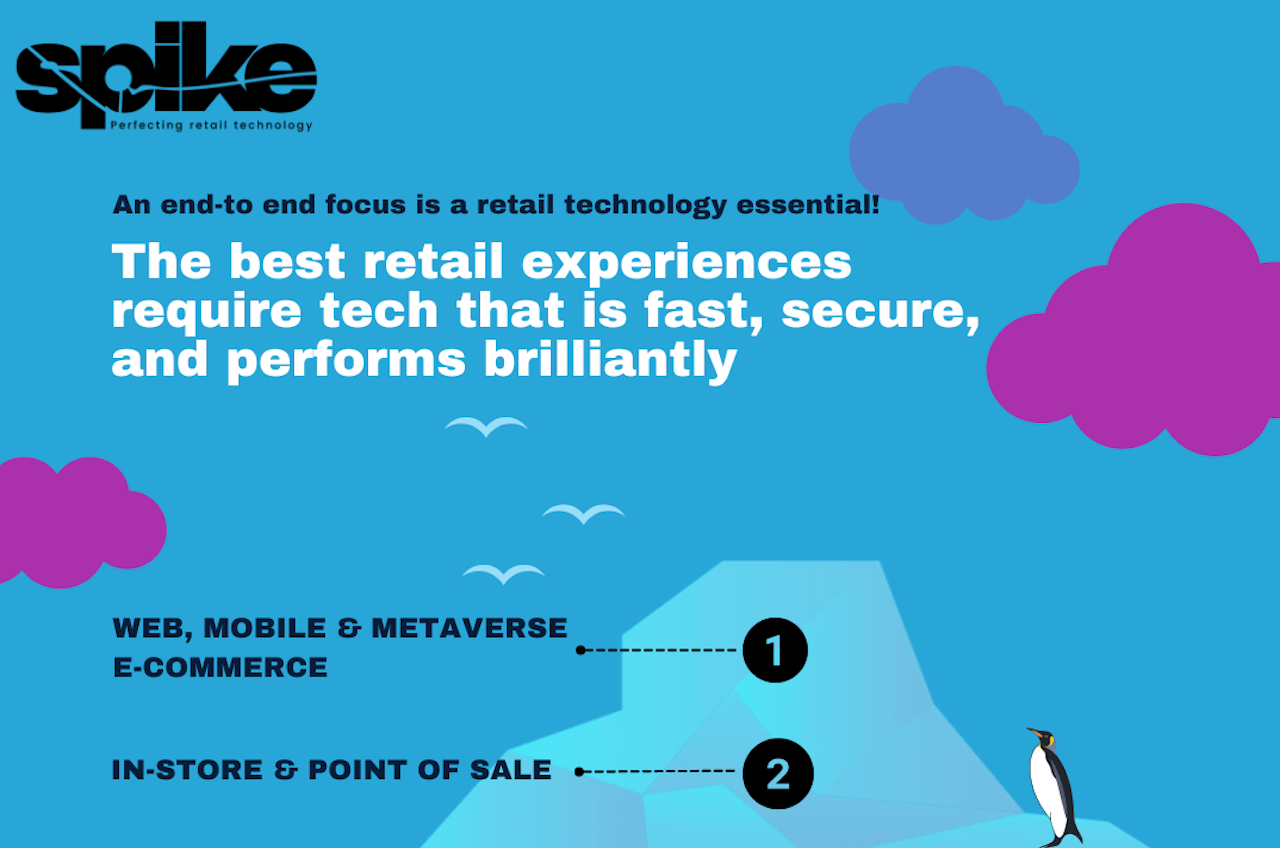Retailers must use automated testing to their advantage
For retailers in 2020, it really is a year of two halves. The first six months brought lockdown, a shutdown of non-essential retail, and a chance to...

The recent Retail Technology Show in London had so much on show that it got us thinking. Hw much tech do you really need? This was backed up by chats with retailers where there was a solid lean towards simplifying the complex.
In our view retailers rarely fail because they lack technology. Retailers fail because they don't know how to make technology work together.
Racing to be up-to-date and innovative, many fall into the trap of stacking new tools (AI, loyalty systems, automation) onto existing infrastructure. Then complexity grows. Integrations crumble. And change grinds to a halt.
This is nothing new – 60% of retailers cite integration complexities as a major hurdle in implementing new systems. But the surging trend of vendors promising 'plug-and-play' simplicity (and time-starved retailers believing them) exacerbates the issue.
The result? A growing tech stack without properly validated performance or integration stability.
Yes, keeping up with competitors is essential. But outpacing risk is more so.
This article outlines the three most significant risks of an expanding tech stack and gives you a three-step framework for risk-free expansion to grow your tech stack without growing your risk. We've also included call outs to case studies showing what's possible and how you can save a ton of cost and our free change readiness survey.
Read on for more or skip straight to the framework here.
We've worked with some of the UK's biggest retailers to de-risk complex tech transformations. Across hundreds of projects, three recurring pitfalls stand out:
The 'Plug-and-Play' Myth – Why new systems rarely 'just work'.
Shrinking Visibility – When oversight disappears in a growing stack.
Go-Live Gamble – When launch is treated as the first real test.
Each leads to outages, lost revenue, and failed digital transformation projects. Here's how to avoid them.
Not every cloud has a silver lining.
Vendors love to sell the dream of frictionless integration: pre-built APIs, drag-and-drop connectors, and 'seamless' cloud compatibility.
Time and resource-starved retailers love it, too. Until it breaks.
APIs time out, data formats clash, and response times collapse under heavy traffic.
Most 'plug-and-play' integrations only cover basic use cases. They stumble as soon as they hit real-world retail complexity (custom pricing, legacy data structures, omnichannel workflows).
Case in Point: Currys' Salesforce Commerce Transformation. Currys needed to integrate Salesforce Commerce Cloud across a complex omnichannel estate. Pre-built connectors weren't enough. Spike delivered a thoroughly tested, risk-free deployment, ensuring the platform could scale to handle 5 million customers per week without failure.
How to survive the myth:
Test like it's live before it's live:
Simulate peak demand scenarios.
Run exhaustive API compatibility checks.
Identify and patch data mismatches before they hit production.
This ensures integrations work under actual retail conditions.
There is no true plug-and-play in complex retail environments. Retail IT teams should budget thoroughly to test any instant integration and be sceptical of bold claims.
Mobile apps, eCommerce platforms, CRM – the more you add, the harder it is to see what's happening across your business.
The reality for many retailers is a tangled web of legacy systems and new cloud services, each with its own dashboards, KPIs, and support teams. Technology teams work in a fragmented way, with different reporting lines, becoming a major constraint when your change roadmap requires coordination across all systems.
No end-to-end oversight forces you to react to problems instead of preventing them.
Case in Point: Lovehoney's ERP Consolidation. Lovehoney expanded fast – multiple global entities, ERP instances, and a fractured data landscape. They needed confidence that a new NetSuite implementation wouldn't disrupt critical business operations. Spike's automation framework reduced regression testing from 12 weeks to 12 hours, catching issues before they hit production.
Prioritise one unified view:
Pull data from every system into a single source of truth.
Real-time alerts flag issues before customers do.
Automated test cycles to reduce new blind spots.
AI-driven monitoring to track anomalies before they turn into failures.
This stops you from flying blind and keeps technology moving with certainty. Most importantly, it gives you confidence on where to start and in making system changes. With that confidence comes peace of mind (and a better night’s sleep!).
And isn’t that worth it’s weight in gold?
Vendor assurances can lead to overconfidence that everything will work perfectly once the switch is flipped. So, in the rush to deploy, some retailers treat the actual go-live as the first real test of the system.
We’ll be frank – this is naive. Stress-test your systems before the real stress hits.
If you remember anything, remember this: "Test-in-prod" leads to risk. Technology must work under pressure – not just in the test environment. Basic functionality checks or small pilot runs aren't good enough for complex retail scenarios.
Case in Point: NOTHS Performance Readiness. Not on the High Street (NOTHS) had concerns about platform stability during peak events like Black Friday. Spike ran full-scale performance simulations ahead of time, preventing bottlenecks and ensuring they were fully prepared for peak demand.
Simple steps for predictable, risk-free go-lives:
Full-volume load testing before launch
Edge-case scenario testing under accurate traffic loads
Rollback-proof deployments with live failover plans
Retail technology moves fast – it’s a high-stakes game. We keep it from breaking. One wrong move, one oversight, and it can cost you millions. To help ensure your systems keep up with the pace of change and eliminate bottlenecks, blind spots, and last-minute chaos, we've outlined a three-step framework to set you on the right track.
To de-risk your growing tech stack, you must be honest with where you are now and your ability to handle the coming changes, and rigorously test before you hit the big go-live button.
Before introducing new platforms or integrations, retailers must understand their existing stack's weaknesses, dependencies, and risk points. Most failures occur not because the latest technology is flawed but because it collides with undetected fragilities in your existing environment.
Conduct a system audit:
Identify undocumented integrations and manual workarounds that could break under change.
Assess legacy systems for compatibility risks – Will the new tech disrupt what's already working?
Map out data flows – How do orders, stock updates, and customer interactions currently move across platforms?
Analyse test maturity – Are existing processes robust enough to validate future expansion?
From there, categorise and prioritise.
For example, you might categorise any risks you identify on a sliding scale, from "known safe zone" to "high-risk weak links".
You could highlight surfaces where failure is most likely, such as fragile APIs, unstable middleware or overloaded databases.
The important thing is to prioritise what must be fixed before you expand.
Bringing in tech that helps you hang onto your customers is crucial. But first, you must be brutally honest about whether you're equipped to land new technology.
The best way to do this is to score yourself. Look at:
Whether you're confident with change
Your ability to change
How mature your delivery is
If you're geared up for whatever nastiness the future throws your way
This will give you valuable insights into your strengths, weaknesses, and areas for improvement regarding tech adoption and change readiness.
To help here, we've created a swift 15-question change readiness scorecard that will give you frank feedback on your ability to effect change in your business, covering everything from your current situation to how ready you are for the future technology you'll need to stay competitive. You can learn everything you need to take this survey here.
(Or, if you're ready to dive in, jump straight to the scorecard).
It's free. It takes around ten minutes, and you will get your personalised results straight to your inbox.
Most retailers only test whether a new system 'works.' But retail systems rarely fail in testing. They fail when customers start using them.
Test whether it holds up under real-world stress, peak traffic, and unpredictable scenarios.
Mirror real-world conditions (e.g., API delays, peak sales surges, stock fluctuations. Data is key here for understanding the effects of production, like volumes in test).
Identify edge-case failures (e.g., mismatched SKUs, incorrect pricing updates, broken promotions).
Verify transaction integrity – ensuring no lost orders, incorrect payments, or misallocated stock.
Ensure order-to-fulfillment workflows function across POS, ERP, CRM, WMS, and finance systems.
Detect failures before they hit customers.
Reduce manual testing overhead, increasing speed without compromising quality.
Simulate Black Friday-style peak loads to ensure your stack won't collapse.
Identify latency bottlenecks (e.g., slow API response times, database query overloads).
Validate that inventory and order management systems scale under pressure.
No technology launch is risk-free. However, how quickly you detect and fix failures determines their impact.
Retail's most successful brands ensure every system (new or old) performs under pressure and that risk doesn't have to grow at the same rate as their tech estate.
The retailers who will dominate the next five years will:
Scale with zero operational disruption.
Prevent costly failures before they happen.
Build resilient, high-performance systems that customers can trust.
(At least, that's our dream).
We are Change Flow Maximisation Experts for Retail Technology.
We help retailers to deploy technology change with certainty. We’re all about proving quality and performance and creating visibility and confidence so you can increase the pace of change, eliminate bottlenecks and blind spots, and remove last minute go-live chaos.
More features, slick platform integration and increased performance drive higher customer retention and increased order value. And long-term gains through a simpler, scalable tech stack and lower tech debt.
We work exclusively with retailers bringing you a Clarity of Vision Blueprint within 30 days and Go-Live Certainty at Speed within 6 months using our unique FLOW mechanism, our proven set of tools and techniques.

For retailers in 2020, it really is a year of two halves. The first six months brought lockdown, a shutdown of non-essential retail, and a chance to...

1 min read
2024: another year of pressure for retailers. As if running an online retail business wasn't already a circus, retailers had to brace and...

The retail technology iceberg illustrates the complex landscape of retail tech.

Bringing Retail Technology To Life - Assurance & Confidence Our role is to bring retail technology to life, which in short means providing confidence...

We took a moment to unwind after two eventful days at the Retail Technology Show 2025. Reflecting on some interesting insights gathered during the...

AI-Powered Technology is Fundamentally Changing Retail As AI-powered technology continues to evolve, we can expect to see even more innovation in the...